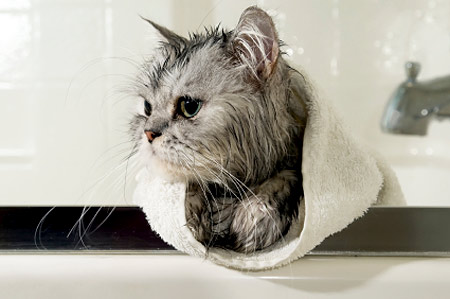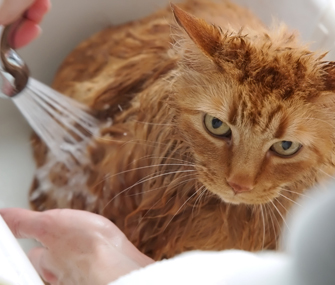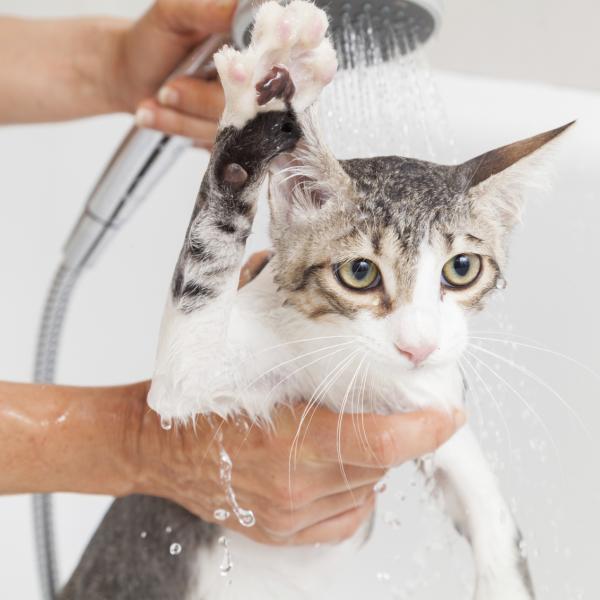Cats have very impeccable grooming habits, and they are very well known for their hatred of getting wet. Taking a bath is a very stressful experience for cats. Generally, cats are obsessively and incredibly clean. They meticulously clean themselves with their little sandpaper-like tongue from the top of their heads to the tip of their tails. But, there are rare occasions when bathing your pet cat is merely unavoidable.
Why cats need a bath?

Cats love to keep clean themselves, and you can call them fastidious groomers. According to an estimate, most cats spend at least 35 to 40% of their day cleaning themselves. That is the reason there is no need to give them a bath in everyday situations.
In some situations, it is nearly impossible for felines also to groom themselves adequately. Sometimes, however, felines can’t groom themselves properly. Some of the situations when your cat needs your help in the tedious task are:
- When your cat comes into contact with toxic substances
- Cat has long hairs, or they get older.
- Arthritic cats also need our help to remain clean sometimes.
- Sick or depressed cats are also not able to spend more time grooming.
- Overweight kitties may have a hard time reaching certain parts of their bodies.
Do cats hate to take a bath?

Cat’s like water – as long as it is on her terms and conditions. Few cats show curiosity about water, and a rare breed of domestic cat (Turkish Van) is famous as a ‘’swimming cat’’. But when you try to submerge a cat in water, be ready to experience ending up with scratches and bites all over your body, a scared kitty that you need to find somewhere hiding in the house, and water everywhere on the floor.
But, what cats are scared about taking a bath?
There is no particular answer to this question, and no one knows for sure. According to some behaviorists, the early ancestors of domestic cats lived in dry regions of Africa, where they had almost no exposure to water. This behavior is inherited by domestic cats, which is why they show unassociated behavior with water. But it doesn’t mean cats can’t swim; they can make doggie paddles just like other canine animals.
When you find your feline feeling not comfortable grooming themselves, it is the time when you need a groomer for them. Groomers are expensive, and most of the time, no one wants to put out their extra cash for bathing their cats.
You can visit your veterinarian to get some help and recommendation for a medicated shampoo when your pet cat is facing a particular bacterial or yeast infection or allergic skin disease. Don’t worry; it is easy to bathe your cat at home. It would help if you kept a few basic things in mind to be prepared in advance, and that’s all.
Preparations before giving a bath to your cat:

Before starting bathing your cat, it is advised to keep everything you need in your reach to avoid any inconvenience or delay during the bath. The things you mainly need for bathing your cat are:
- A brush to remove mats and knots
- Use a bathtub, plastic bucket, or sink as a cat bath.
- Cat or kitten shampoo
- Cat conditioner
- Towel
Always use a recommended medicated shampoo for cats or find a mild all-rounder shampoo with no harsh chemicals and no perfume.
Steps to follow during bathing your cat:

It is essential to prepare yourself and your kitty for a bath before starting this adventure. With proper preparations and a little practice, grooming at home can be less stressful, more comfortable, and affordable:
- As you brush your dog before giving a bath to them, similarly brush your cat to remove dirt and mats from the cat’s hair. Mats are difficult to come out of cats’ hairs if you get them wet.
- Add warm water into the bathtub or bucket about 4 to 5 inches.
- Place your kitty in the bathtub with gentle hands and wet their body with hot water with the help of a cup or hose attachment.
- Avoid bathing the head areas of your cat and only focus on the fur from their neck to their tail.
- After making your cats thoroughly wet, lather their body with kitty shampoo and make sure to lather the underside also.
- Now rinse your cat’s body, avoiding the head part until you feel no more shampoo in the cat’s hairs.
- Apply conditioner in the same manner if required.
- Now wrap the cat in a towel to absorb excess water and gently dry her body with another towel.
- At the end of this entire activity, give your kitty a treat to encourage and praise her for being nice.
- Never use a hairdryer on your cat! It has too much heat that is unbearable for the sensitive skin of your cat.
NOTE: If you are bathing your cat for fleas, use cat-specific shampoo only. Dog flea shampoo can be toxic to the cat’s skin.
How often a cat needs a bath?

In general, there is no need to give a bath to your cats, but if it is required, then once a month is enough for bathing your cat. Otherwise, more than once bathing a cat irritates or dry out her skin. Forgiving your adult cat a bath, always use a wide bucket or a bathtub, while the kittens feel more relaxed and comfortable in a small tub or bathroom sink.
Conclusion:
Bath time can be a challenging task for you and your feline friend, but you can make it a relatively easy job for both of you by following these tips:
- Start bathing your cat from an early age when she is a kitten.
- Allow her to play in the water on and off to become used to.
- Use something to sink her claws into like a towel during a bath.
- Be quick in all this procedure.
We hope our article helps you give your feline fellow the ultimate level of love and care while maintaining its hygiene. Do let us know if you have any further queries.
